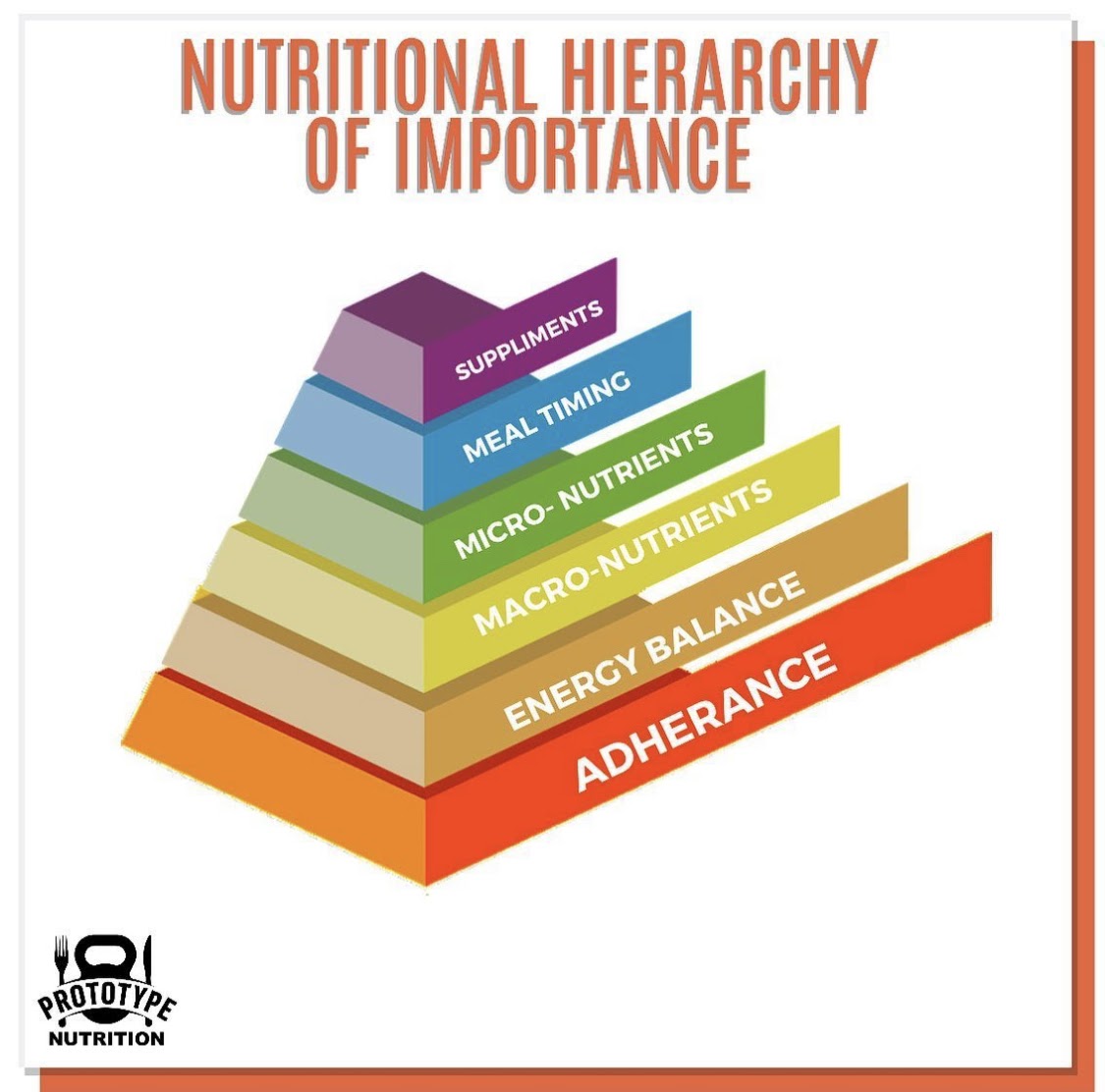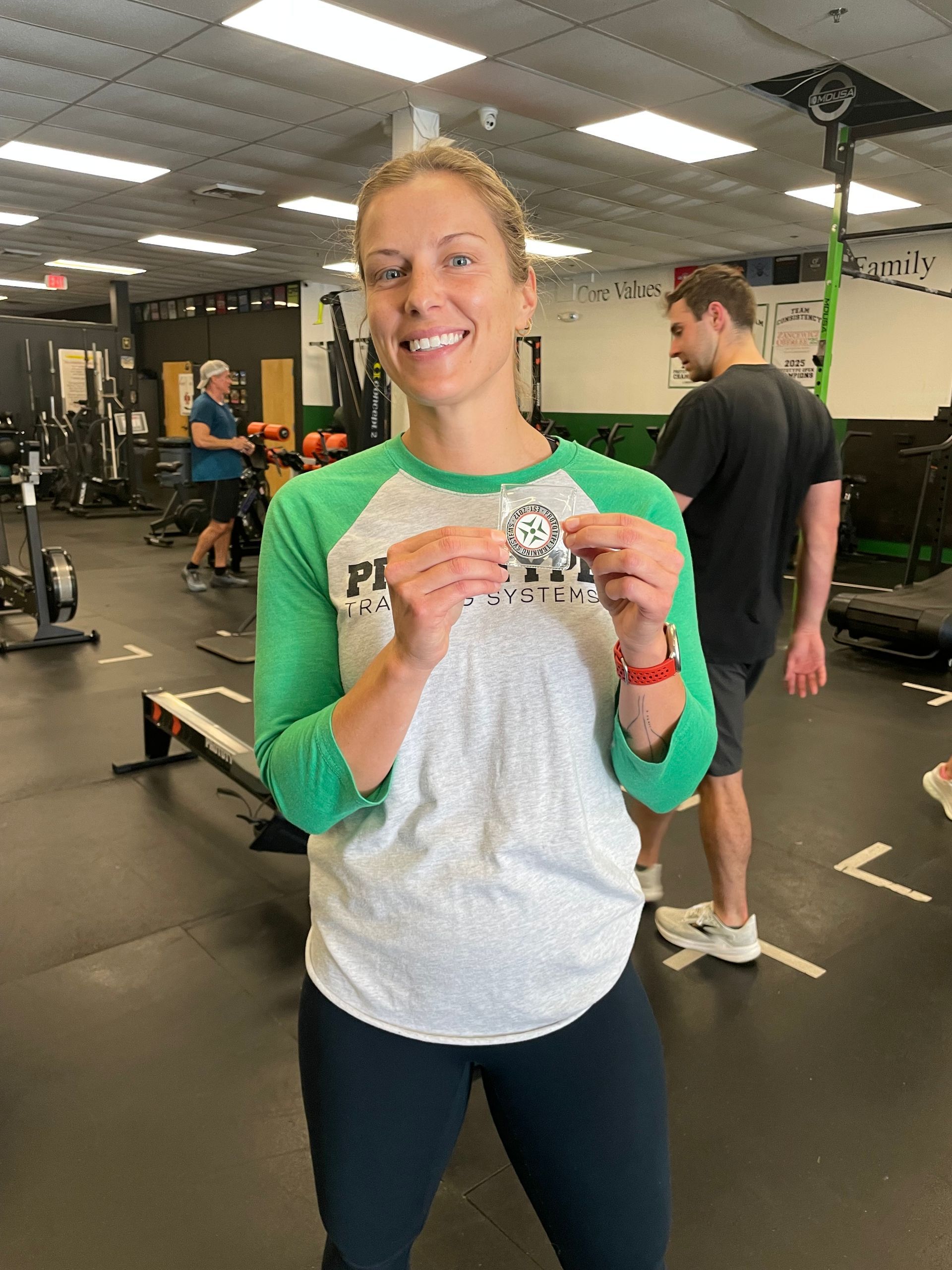The 5 Levels of Nutrition
The 5 Levels of Nutrition
By: Jon Collette (Prototype Nutrition Coach)

Coach Jon here again with another nutrition post and today’s topic is going to be on the 5 levels of Nutrition or in other words, the Nutritional Hierarchy of Importance (NHI for short!).
What is the Nutritional Hierarchy of Importance?
The Nutritional Hierarchy of Importance (pyramid image above) is a visual of the behaviors AND components of nutrition that should always take priority before the other. The foundation of the pyramid is what’s the most important to focus on and master first while the top of the pyramid should come last. Everything on the pyramid from the bottom up is also determined based on your lifestyle and behaviors.
1.) What does ADHERENCE mean?
Adherence is the MOST IMPORTANT component of the pyramid and it stands for sustainability. Oftentimes we jump to supplements for quick fixes. We need to figure out what is easiest to ADHERE to while still being able to stay on track with our goals. If you start something, let’s say it’s the keto diet, you will need to ask yourself, “can I do this forever?” If the answer is NO, chances are you will continue to bounce from diet to diet without any consistent structure. Now if you can sustain a lifestyle like the Keto Diet, then all the power to you! Adherence again is the most important thing for lasting results no matter what your goal is.
2.) What is Energy Balance?
Energy Balance, simply put, is the balance of the energy you take in vs. the energy you put out. The amount of energy (calories) you put in your body will vary based on your current weight, body fat percentage, activity level, gender, age, preference, and of course goals. The energy we take in comes from the foods we eat while the energy we expend or put out is credited to a few different factors:
- Basal Metabolic Rate (BMR)
- Non-Exercise Activity Thermogenesis (NEAT)
- Thermic Effect of Food (TEF)
- Purposeful Exercise (PE)
What is BMR?
BRM stands for basal metabolic rate and that’s the amount of energy (calories) you expend just to stay alive. There isn’t a huge variation in this number based on body weight but the more muscle mass you have, the higher the BMR you will have compared to someone of the same weight with less muscle mass. For example, a 150lb male might have a BMR of 1500-1800 calories in a 24 hour period just because their heart, lungs, and kidneys are constantly operating. This accounts for about 60% of your daily energy expenditure.
The reason why this is so important is that most people undereat and undereating eventually leads to overeating. Overeating (in this example) occurs because you’ve been burning calories in a severe of a caloric deficit. Eating too little can lead to binge eating (overconsumption of calories in a large amount, typically in one sitting) which pushes you into a calorie surplus. Basically, if you’re not eating enough food, you will get REALLY hungry and then eat more than you would if you just ate consistently the same amount of calories every single day. Remember, steady progress is better than really fast progress or none at all.
What is NEAT?
NEAT stands for Non-Exercise Activity Thermogenesis which is the energy you burn just doing your activities of daily living. At Prototype, we like to call this unstructured physical activity. This might look like typing on a keyboard, walking your dog, doing yard work, a paperboy (maybe paper person?) doing their routes, tapping your foot to your favorite song… etc. Anything that you are doing that isn’t purposeful exercise (like going to the gym). This might account for 5-15% of your daily energy expenditure.
What is TEF?
TEF stands for the Thermic Effect of Food, which is the energy you expend metabolizing the food you eat. An easy way to think of this is to think about little construction workers in your body breaking down the food with little hammers to help you digest and absorb the nutrients. Depending on the types of foods (macronutrient profile/fiber intake) this can account for up to 10% of your calorie expenditure. The macronutrient that requires the MOST amount of energy just to break it down is… PROTEIN! So make sure to hit your protein totals each day, you’ll burn more energy!
What is PE?
PE stands for Purposeful Exercise. At Prototype, we like to call this structured physical activity. There are a WIDE range of things you can do for your purposeful exercise AND the duration and intensity will impact your daily energy expenditure. Examples of what PE could be would be: Running, weightlifting, swimming, CrossFit, group exercise, Yoga… you know what I’m saying! PE=you’re moving to burn calories!
It’s important to understand these components at a high level because exercise along (or PE) isn’t the only way you can expend energy. Energy Balance is understanding how much we are taking in and also understanding roughly how much we are expanding. Your intake will look very different than someone of a different size that moves more or less than you. Because of this, at Prototype Nutrition, we preach that nutrition needs to be individualized to see the best results. If it’s not and you are doing some sort of cookie-cutter program, it might not be appropriate for you and your lifestyle.
3.) What are macronutrients?
Macronutrients are simply Protein, Carbohydrates, and fats, these are the Key Nutrients that make up the food that we eat. The majority of your calories come from these nutrients and they each have a role in the body. Depending on your activity and goals the ratio of these macronutrients will vary.
Protein
- They are the building blocks of our tissues (muscle, bone, organs, muscle tissue, brain, skin hair, and nails) and everything in our body needs protein to grow and repair.
- Keeps us healthy, strong increases recovery from exercise-induced stress.
- Supports growth & development.
- Contains 4 calories per gram (so 20g of protein=80 calories)
Carbohydrates
- The main fuel source for our body and brain.
- The quickest energy source that supports exercise.
- Fiber (a type of carbohydrate the body can’t digest. Also soluble & insoluble) have benefits on gut health, cardiovascular health and helps support stable blood sugar levels.
- Athletes training at a high level should have higher carb intakes than most sedentary individuals for optimal performance.
- Like protein, they contain 4 calories per gram (so 20g of carbohydrates=80 calories)
Fat
- Gives you energy and supports cell growth.
- Supports joint health (anti-inflammatory fats like omega 3).
- Enhances Cognitive function.
- Allows the absorption of fat-soluble vitamins (A,D,E,K).
- Contains 9 calories per gram (so 20g of fat=180 calories).
4.) What are Micro-nutrients?
Vitamins, minerals, and hydration – are necessary to keep our immune system strong, for overall optimal function and performance. The best way to get these is through eating nutrient-dense foods like fruits and veggies!
Role of Vitamins & Minerals
- Support the overall optimal function to keep us alive.
- Help keep our immune system strong, protects us from viruses and disease.
- Helps to convert the food we eat (Macronutrients) into energy.
️5.) What is Meal timing?
Meal timing refers to how often we eat, when we eat, and any sort of macro manipulation. This is an advanced action for those who have the foundation down. Meal timing can have benefits on exercise performance and should coexist with how you typically like to structure your day. Some might like 3 meals and some might enjoy 5 small meals and snacks. When you eat shouldn’t be as important as how much you eat and what nutrients you’re eating.
6.) What are Supplements? (nutritional supplements)
First of all, we aren’t talking about steroids! Supplements are more often than not processed, dense nutrition that you can take to aid to add to an already well-balanced diet. For example, buying a whey protein powder would be considered a nutritional supplement that you can take to help you get more protein into your diet if you’re finding it hard to hit a particular target protein goal. Supplements should be the icing on the cake of an already well-established nutrition plan and can be a waste of money if other habits aren’t there. An example of this is if you’re taking a multivitamin and not eating enough fruit and veggies, you should rethink the benefits of the supplement.
Summary:
- ️Focus on mastering the foundation of this pyramid and then build your way up.
- Ask yourself “can I do this forever?”
- Undereating isn’t the solution, consistency is.
- There are more ways to burn and use energy than just exercise.
- Focus on 1-4 before 5 and 6.
- If you need help, we can help you. Just let us know!
The post The 5 Levels of Nutrition appeared first on Prototype Training Systems.
Previous Blogs

Climb to New Heights
Prototype Training Systems is more than a gym - it is a lifestyle. Join us today!



